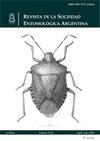Characterization of the mosquito community in diurnal activity in an urban ecological reserve
IF 0.5
4区 农林科学
Q4 ENTOMOLOGY
引用次数: 0
Abstract
Knowing the composition of mosquito community, their temporal dynamics and relationship with abiotic factors in urban areas is of interest in public health because many species are vectors of pathogens. This is the first survey of diurnal adult mosquitoes in an urban reserve in Buenos Aires City (Argentina). Fortnightly daytime samples were carried out during a year affected by a drought due to La Niña effect, to describe the adult mosquito community and analyze its association with environmental variables. Ten species belonging to the genera Culex L., Aedes Meigen, Psorophora Robineau-Desvoidy and Mansonia Blanchard were captured, some of which are vectors of pathogens (e.g. Aedes albifasciatus (Macquart) and the complex Culex pipiens L.). Diversity did not vary significantly among seasons, and the composition was moderately similar (ANOVA: p = 0.11; Dice-Sorensen: 0.50-0.77). However, classification of species as core, common or rare in the community varied. A canonical correspondence analysis allowed us to identify a group of five species associated with summer and high temperatures. The other species were not grouped, and were associated with rainfall, relative humidity or another season. These associations help to understand the presence and abundance of those species during a prolonged drought.某城市生态保护区蚊虫群落日活动特征
了解城市地区蚊虫群落的组成、时间动态及其与非生物因素的关系对公共卫生具有重要意义,因为许多物种是病原体的媒介。这是在布宜诺斯艾利斯市(阿根廷)的一个城市保护区进行的首次成蚊昼夜调查。在受La Niña效应影响的一年里,每两周进行一次白天采样,以描述成蚊群落并分析其与环境变量的关系。捕获库蚊属、美根伊蚊属、褐斑伊蚊属、褐斑伊蚊属10种,其中部分为病原菌媒介(如白纹伊蚊(麦夸特)和复合库蚊)。不同季节间多样性差异不显著,组成相似程度中等(方差分析:p = 0.11;Dice-Sorensen: 0.50 - -0.77)。群落中核心种、常见种和稀有种的分类存在差异。典型对应分析使我们能够识别出与夏季和高温有关的五种物种。其他种类没有分组,与降雨、相对湿度或其他季节有关。这些联系有助于了解这些物种在长期干旱期间的存在和丰富程度。
本文章由计算机程序翻译,如有差异,请以英文原文为准。
求助全文
约1分钟内获得全文
求助全文
来源期刊

Revista De La Sociedad Entomologica Argentina
Agricultural and Biological Sciences-Insect Science
CiteScore
0.80
自引率
20.00%
发文量
31
审稿时长
20 weeks
 求助内容:
求助内容: 应助结果提醒方式:
应助结果提醒方式:


